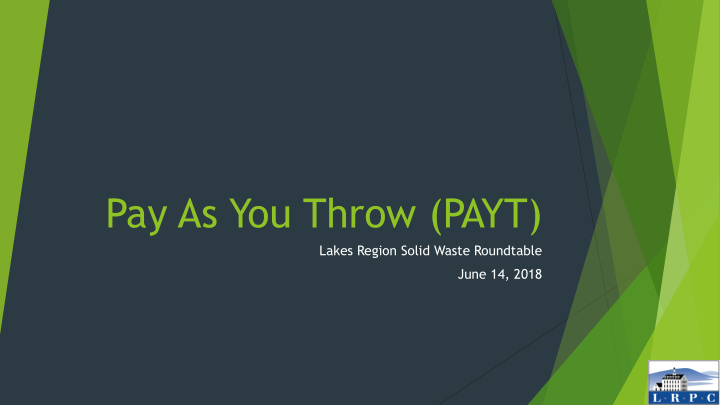



Pay As You Throw (PAYT) Lakes Region Solid Waste Roundtable June 14, 2018
PAYT - Overview Flat Rate Waste Disposal What is PAYT? Design Variations What are the pros? What are the cons? Examples/Case Studies Implementation Keys to Success Resources 2
Flat Rate Waste Disposal Residents pay a fixed amount for waste disposal services Those who generate less subsidize those who generate more Users (generators) don’t usually know the actual costs of disposal Generators usually pay little attention to the amount of waste produced Reduction of waste is not encouraged Recycling is not priority May have additional fees for disposal of certain types of wastes 3
PAYT: What is PAYT? Residents dispose of waste in prepaid bags or containers IDEAL PAYT system: measures the amount of individual waste collected and charges the waste producer a fee equal to the cost of disposal Waste generators pay for disposal of their own waste Creates an economic incentive for waste reduction It is up to the individual to reduce/reuse/recycle/compost Treats waste disposal more like a utility Pay for electricity out of property taxes? Pay flat rate for “all you can use” electricity? 4
PAYT – Design Variability Full Unit Pricing Users pay for all the garbage that they dispose of Partial Unit Pricing No charge for base amount Additional bags/containers paid for by user Variable-Rate Pricing Resident chooses size of container to rent/bags to purchase Price corresponds to volume 5
PAYT – Variations • Other names: Unit-Based pricing • Variable Rate Pricing • • User Pay Save Money and Reduce Trash (SMART) • • Cash or Measured: Individual waste is measured and the resident pays the fee equal to the cost of generation Mechanisms • • Cash Overflow • • Variable Rate Carts Tags • Bags • • Not all versions of PAYT are the same (See Waste Zero handout) • 6
PAYT – Pros Disposal as a utility Generators charged for the service that they use Reduces costs to the community – can be cost-neutral Preserves tax revenue for other purposes Allows for expansion of services (equipment and staff) Reduces or eliminates need to raise taxes or fees due to waste disposal Waste reduction (usually 20-45%), doubling of recycling rates Flexible systems (local government, haulers, customer needs) Incentive-based, encourages individual responsibility Generally reduces fixed residential fees for trash collection Results: Cuts MSW by an average of 44%, increasing recycling rates two or three times the average ( source: US EPA study of New England ) 7
PAYT – Cons Opposition to change Requires user awareness of guidelines, how the system works, & their responsibilities Requires outreach and education Winners and losers Large families, residents on fixed income Discounts for low income and/or elderly Requires adequate funding for outreach & education, supervision, billing, and enforcement Dumping of unmarked MSW Rental units & apartments 8
PAYT – Case Studies Two states mandate PAYT (MN & VT) More than 7,000 US communities have adopted PAYT Nearly 60% of MA and Iowa communities 26% of NH residents live in PAYT communities, ranging from Concord and Manchester to Somersworth, Sanbornton, and some of the smallest communities in the state Piermont (pop. 709) Trash disposal cut in half, recycling doubled (50 tons/yr to 98 tons/yr) Fees from bag sales and recyclable income typically covers cost of transfer station, including labor and disposal 9
PAYT – Case Studies Source: WasteZero: PAYT 101 10
PAYT – Case Studies Source: WasteZero: PAYT 101 11
Eliot and Sanford, ME 57% trash reduction in 4 months Saved $8,589 in a town of 6,200 people 12
PAYT – Public Perception Mixed results in NH 13
PAYT – Implementation Estimate total waste once PAYT established Estimate start-up and on-going costs Develop a PAYT pricing structure Equipment, collection, hauling, tipping fee, other fees Labor costs Fixed costs? Some covered by taxes? Decide on system – bags, containers, hybrid Identify additional collection services, such as bulky items Recycling, composting programs? Special procedures/considerations – multi-family, low income, elderly Prep ordinance – requiring PAYT and other forms of disposal illegal 14
PAYT – Education & Promotion Elected officials and the public NOT an added cost – just a change in the way that people pay for waste services Transparency Benefits Garbage as a utility Make users aware of: schedules, locations for purchasing bags/carts, rates, penalties for non- compliance, billing schedules Methods Press releases, newsletters, mailings, utility bills, door hangers Social media, news articles, public meetings 15
PAYT – Education & Promotion Address public perceptions That fee or bag cost is a tax Adverse effects to low-income households Increase in illegal dumping High administration costs Rebut misrepresentations Direct engagement Gather public input Provide program specifics Monitor and evaluate, survey public, analyze problems and issues 16
PAYT – Resources Pay-as-you-throw Now – Lots of free resources for download http://paytnow.org/ PayAsYouThrow.org is a project of the Recycling Foundation – Resources for download http://payasyouthrow.org/ Variable Rate Pricing Guide and Sample Ordinance for Municipalities – Vermont http://dec.vermont.gov/sites/dec/files/wmp/SolidWaste/Documents/Universal- Recycling/VariableRatePricingGuideOrdinance_2015.pdf Pay-As-You-Throw (PAYT)/Save-Money-And-Reduce-Trash (SMART) – Massachusetts https://www.mass.gov/lists/pay-as-you-throw-paytsave-money-and-reduce-trash-smart Success with Pay As You Throw, DSM presentation https://nerc.org/documents/conferences_presentations/Success_with_Pay_As_You_Throw.pdf NERC (Northeast Recycling Cooperative) https://nerc.org/ WasteZero 17
PAYT – Resources Wastezero.com https://nhmunicipal.org/TownAndCity/Article/621 18
Recommend
More recommend